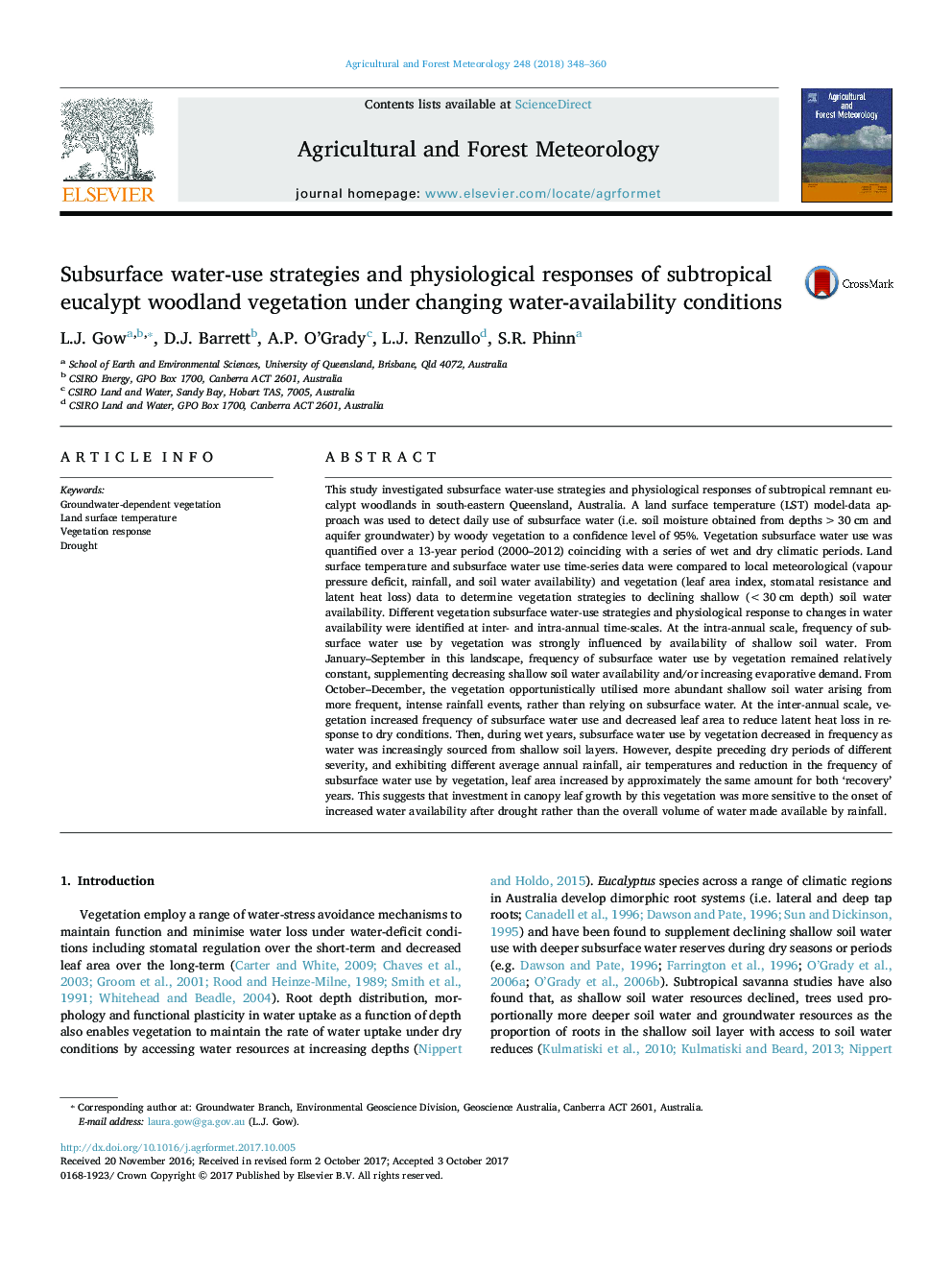| کد مقاله | کد نشریه | سال انتشار | مقاله انگلیسی | نسخه تمام متن |
|---|---|---|---|---|
| 6536879 | 1420853 | 2018 | 13 صفحه PDF | دانلود رایگان |
عنوان انگلیسی مقاله ISI
Subsurface water-use strategies and physiological responses of subtropical eucalypt woodland vegetation under changing water-availability conditions
ترجمه فارسی عنوان
استراتژی های آب زیرزمینی و واکنش های فیزیولوژیکی پوشش گیاهی اکالیپتوس زیرپروپلیتی تحت شرایط تغییر آب در دسترس بودن
دانلود مقاله + سفارش ترجمه
دانلود مقاله ISI انگلیسی
رایگان برای ایرانیان
کلمات کلیدی
گیاه وابسته به آب زیرزمینی، دمای سطح زمین، پاسخ گیاهی، خشکی،
موضوعات مرتبط
مهندسی و علوم پایه
علوم زمین و سیارات
علم هواشناسی
چکیده انگلیسی
This study investigated subsurface water-use strategies and physiological responses of subtropical remnant eucalypt woodlands in south-eastern Queensland, Australia. A land surface temperature (LST) model-data approach was used to detect daily use of subsurface water (i.e. soil moisture obtained from depths >30Â cm and aquifer groundwater) by woody vegetation to a confidence level of 95%. Vegetation subsurface water use was quantified over a 13-year period (2000-2012) coinciding with a series of wet and dry climatic periods. Land surface temperature and subsurface water use time-series data were compared to local meteorological (vapour pressure deficit, rainfall, and soil water availability) and vegetation (leaf area index, stomatal resistance and latent heat loss) data to determine vegetation strategies to declining shallow (<30Â cm depth) soil water availability. Different vegetation subsurface water-use strategies and physiological response to changes in water availability were identified at inter- and intra-annual time-scales. At the intra-annual scale, frequency of subsurface water use by vegetation was strongly influenced by availability of shallow soil water. From January-September in this landscape, frequency of subsurface water use by vegetation remained relatively constant, supplementing decreasing shallow soil water availability and/or increasing evaporative demand. From October-December, the vegetation opportunistically utilised more abundant shallow soil water arising from more frequent, intense rainfall events, rather than relying on subsurface water. At the inter-annual scale, vegetation increased frequency of subsurface water use and decreased leaf area to reduce latent heat loss in response to dry conditions. Then, during wet years, subsurface water use by vegetation decreased in frequency as water was increasingly sourced from shallow soil layers. However, despite preceding dry periods of different severity, and exhibiting different average annual rainfall, air temperatures and reduction in the frequency of subsurface water use by vegetation, leaf area increased by approximately the same amount for both 'recovery' years. This suggests that investment in canopy leaf growth by this vegetation was more sensitive to the onset of increased water availability after drought rather than the overall volume of water made available by rainfall.
ناشر
Database: Elsevier - ScienceDirect (ساینس دایرکت)
Journal: Agricultural and Forest Meteorology - Volume 248, 15 January 2018, Pages 348-360
Journal: Agricultural and Forest Meteorology - Volume 248, 15 January 2018, Pages 348-360
نویسندگان
L.J. Gow, D.J. Barrett, A.P. O'Grady, L.J. Renzullo, S.R. Phinn,
